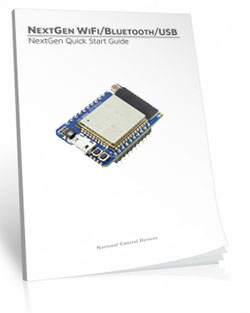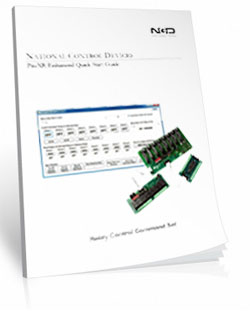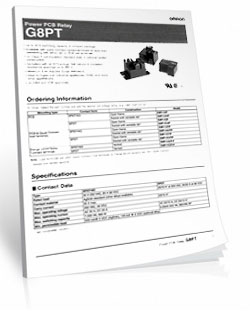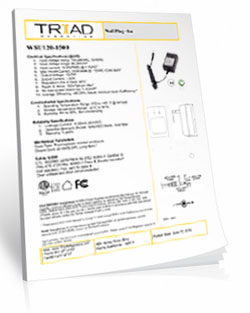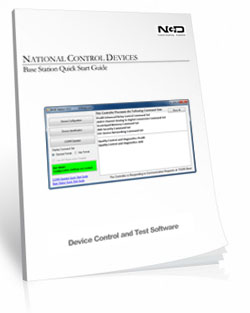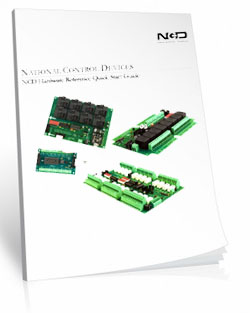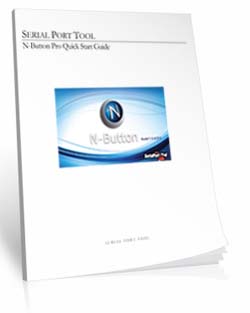Bluetooth Relay 32-Channel 30-Amp with UXP Port
ZUXPR3230PROXR_ZBT
Bluetooth Relay
The ZUXPR3230ProXR_ZBT Bluetooth Relay is equipped with the NexGen Bluetooth/WiFi interface that will allow you control relays wirelessly over a Bluetooth connection. By implementing the Bluetooth Serial Port Profile, the board will appear to your computer as a standard COM port, making it easy to communicate wireless data via Bluetooth between the PC and the device. Users have the ability to set the Bluetooth discovery name and PIN number via the integrated Web Page using Soft AP mode.NexGen Bluetooth Communication
The ZUXPR3230ProXR_ZBT features the NexGen Bluetooth/WiFi communications module that modernizes connectivity by combining WiFi, Bluetooth, USB, and MQTT Communications into a single module. The NexGen module includes firmware that focuses on the most needed features while retaining the flexibility to adapt to just about any application. Using the integrated web page in Soft AP mode, users have the ability to configure the NexGen module by enabling and disabling features as needed.Bluetooth Relay - ProXR
This is a ProXR board meaning that it has the industry leading command set and the board can be expanded to include up to 256 relays. Adding relays is as easy as adding expansion boards as your needs arise.
Bluetooth Relay 32-Channel 30-Amp with UXP Port
ZUXPR3230PROXR_ZBT- OVERVIEW
- NexGen INTERFACE
- NexGen SETUP
- Board Features
- Command Set
- Power & More
- Software
- ACCESSORIES
- Data Sheets
Bluetooth Relay at a Glance
- 32 30-Amp Relays Installed
- Single Pole Double Throw (SPDT) Relay
- Wire to Normally Open Position Only
- Wire Using 1/4" Quick Disconnect Terminal
- Temperature Rating -40° C to 85° C
- Expandable to 256 Relays - Bluetooth Wireless Interface
- 200 to 300 Ft. Wireless Range
- Mounts as a Virtual COM Port on PC/Laptop
- Soft AP Web Interface for Configuration
- FCC Certified Bluetooth with 320′ Range - Industry Leading Command Set
- Send Specific Commands to Control Relay
- Program in Almost any Language - UXP Expansion Port for Adding Additional:
- Contact Closure Modules - up to 256 Inputs
- Digital Potentiometers - up to 48 Inputs
- Analog to Digital Conversion - up to 256 Outputs
Wi-Fi, Bluetooth, USB or Web Page Control
Control this board using standard WiFi TCP/IP communications or use the integrated Bluetooth for simple wireless computer to device interface using a wireless virtual COM port. Easy setup using a integrated Web Page User Interface for all Configuration settings.
WiFi Relay
WiFi Relay Control
The NexGen WiFi is NCD's second generation WiFi communications module that modernizes connectivity by combining WiFi, Bluetooth, USB, and MQTT Communications into a single module. The NexGen WiFi module includes firmware that focuses on the most needed features while retaining the flexibility to adapt to just about any application. Using the integrated web page in Soft AP mode, users have the ability to configure the NexGen WiFi module by enabling and disabling features as needed.Three Interface Options, ONE Module!
WiFi Communications
The NexGen WiFi module supports TCP communications, essentially converting TCP data to serial data for device control. Configure network setting such as DHCP or a Static IP address. Configure the network Port number and serial baud rates for connectivity to the NCD device using the integrated web page while in Soft AP mode. The Soft AP mode is compatible with web browsers on mobile devices such as Android or IOs devices, as well as laptops and desktop computers with integrated WiFi communications. Once configuration data is complete, exit the Soft AP mode and use the optional integrated web page to control basic relay control functions via the integrated web page (non-secure) or send data to the WiFi module using some of the optional protocols supported below.Bluetooth Communications
The NexGen WiFi module also supports Bluetooth connectivity via the Bluetooth Classic protocol. By implementing the Bluetooth Serial Port Profile, NCD products will appear to your computer as a standard COM port, making it easy to communicate wireless data via Bluetooth between the PC and the device. Users have the ability to set the Bluetooth discovery name and PIN number via the integrated Web Page using Soft AP mode.USB Communications
We also built the NexGen WiFi module to include a USB port, which may be used for direct USB communications to the device. Simply configure the USB Virtual COM Port parameters using the Soft AP mode and the integrated web page. The NexGen WiFi module will mount as a COM port on your computer, allowing access to the device through serial communications.WiFi Communication Protocols
MQTT
The NexGen module supports very basic MQTT usage. It can be configured to connect to an MQTT broker using no auth or basic auth (username/password). Testing of this functionality was done using beebotte.com. The NexGen WiFi module implements one subscribe topic and one publish topic. It listens for control commands over the subscribe topic and sends command responses to the publish topic, which may be user defined using the integrated web page in Soft AP mode.HTTP
Using WiFi communications, it's also possible to send commands to NCD devices using the HTTP API. For example, to activate a relay on a NCD device, Simply send the HTTP command to the IP address 192.168.1.10 in any web browser using the following command structure: 192.168.1.10/sendCommand?data:[254,108,1]Web Socket
Use a Web Socket to send commands to a NCD device. Users can establish a web socket to the board via ws://{controller IP}/ws. This web socket expects command bytes to be sent in the form of a JSON array, for example “[254,108,1]” (activate the first relay on a NCD relay board). Note this array should be sent in TEXT/String format as shown with quotes. Any data received from the host board will be sent to the web socket in the same format (JSON Array).Discovery and Diagnostics
UDP Broadcast
The NexGen module broadcasts a UDP packet on ports 55555 and 13000 for network discovery purposes. This allows discovery of the the NexGen WiFi module in Base Station and may be used for network discovery in your own software applications.RGB Status LED
The integrated RGB LED displays communications and status information. Diagnose connectivity status or communication problems with different flashing color patterns to indicate module bootup, wifi connectivity, and configuration modes.Taralist NTP Time Sync
This option enables Network Time Protocol time syncing of the Taralist Real Time clock. When enabled, once per day the NexGen module will sync it’s time with time.google.com, then it will update the on board Taralist Real Time clock. Note that this feature is only valid on Taralist series relay controllers and will only work if WiFi is enabled and internet connectivity is present on the connected WiFi Network.Compatibility
For use with 2.4GHz WiFi Networks ONLY. This module does NOT support 5GHz WiFi.PLEASE CONSULT WITH NCD STAFF PRIOR TO RETROFITTING OLDER DEVICES WITH THIS MODULE!
ONLY NEWLY PURCHASED CONTROLLERS ARE COMPATIBLE WITH THIS MODULE!
In general, this WiFi module works with Fusion series controllers regardless of version. However, this module is NOT COMPATIBLE with older relay boards that you may want to retrofit with WiFi communications. This module requires more power than older devices are capable of supplying. This device is fully compatible with any “G2” board revision, such as boards marked with Rev G2A, G2B, G2C, etc. G2 boards are typically black in color with the exception of Taralist controllers, which are also black in color but NOT equipped with G2 revision markings (and not compatible). If G2 is not marked on the board revision and you are not using a Fusion series controller, this module is NOT compatible. Newly purchased controllers will include a power supply upgrade, allowing compatibility. A service charge to upgrade the power supply on older devices may apply when retrofitting this module.
WiFi Bluetooth USB 3 in 1 Module with MQTT Support
Control NCD devices using standard WiFi TCP/IP communications or use the integrated Bluetooth for simple wireless computer to device interface using a wireless virtual COM port. Use the USB port for control over a virtual COM port for easy connectivity. Integrated web server allows control of select NCD relay controllers using a built-in non-secure web page. This is a low-cost solution that lets you try different solutions with easy setup using a integrated Web Page User Interface for all Configuration settings. Connect to a MQTT Server over WiFi for remote operation over the internet.Configure The Features Needed
Using the integrated web page in Soft AP mode, users have the ability to configure the NexGen WiFi module by enabling and disabling features as needed.
NexGen Module Setup
The NexGen module implements all the same functionality from our previously supplied WiFi, Bluetooth and USB modules but adds additional functionality including a simple web interface for configuration, Bluetooth interface, USB interface, we built in web interface for rudimentary control of select relay products, and MQTT compatibility. We will now cover the configuration of the module.Configuring the NexGen module
To configure a new NexGen module make sure it is installed in a Host board(Relay controller or other product) and it’s LED is flashing Blue. A Blue flashing LED indicates it is in configuration mode. In this mode the module will appear as a WiFi Access point and should show up as an available WiFi network on your computer called NCD_WiFi. Connect to the NCD_WiFi network and enter NCDBeast as the password.Your computer may now automatically pop up a browser window where you can configure the module. If not simply open your web browser and enter 172.217.28.1
You should now see the Configuration Web Interface. We will now cover those options.
WiFi
Here we will cover the WiFi options section of configuration. These are configuration options for associating the WiFi module with your WiFi network. Note that the NexGen module will scan for networks on initial power up and these will be displayed. If you have a hidden network(does not broadcast an SSID) please contact support.Enabled
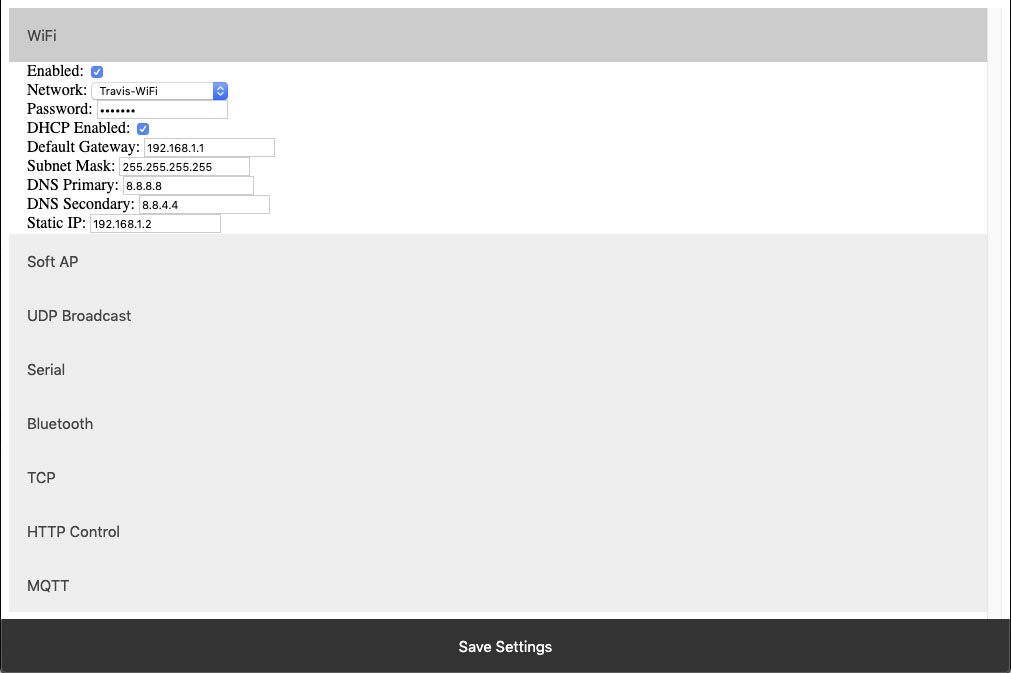 This setting configures whether or not the module should attempt to associate with a WiFi Network.
This setting configures whether or not the module should attempt to associate with a WiFi Network.
Network
This Setting indicates the SSID of the network the module should associate with on power up.Password
This Setting indicates the password which should be used to associate with the network configured through the Network setting.DHCP Enabled
This setting indicates whether the NexGen module should obtain an IP address from a DHCP managed router or if it should use following static IP address settings. Checked indicates to utilize DHCP(Recommended for most applications).Default Gateway
This setting indicates the default gateway the module should communicate through(IP of router). This setting is only applicable if DHCP is not checked.Subnet Mask:
This setting indicates the subnet mask which should be utilized on the network. This setting is only applicable if DHCP is not checked.DNS Primary
This setting indicates the default DNS server to utilize for internet connection to host URLs. This setting is only applicable if DHCP is not checked. If DHCP is checked the default DNS server of the network router will be used.DNS Secondary
This setting indicates the backup DNS server to utilize for internet connection to host URLs. This setting is only applicable if DHCP is not checked. If DHCP is checked the backup DNS server of the network router will be used.Static IP
This setting indicates the Static IP address the NexGen module should utilize once connected to the host network. This setting is only applicable if DHCP is not checked.Soft AP
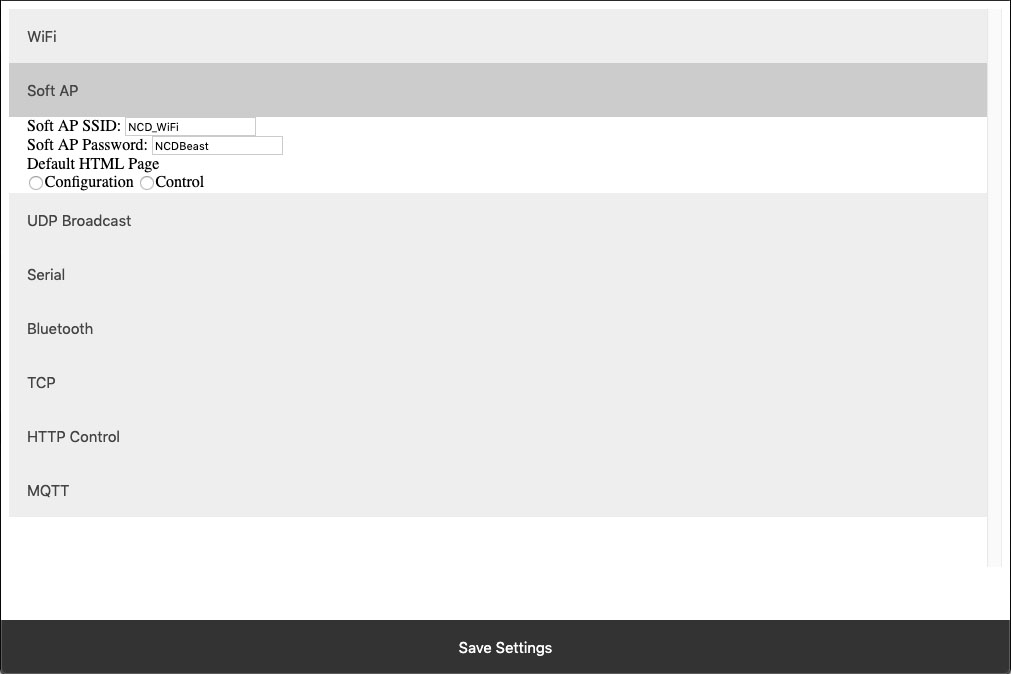 In configuration mode the NexGen module is broadcasts and SSID which devices can connect to. This Soft AP is configurable. It is possible to change the broadcast SSID network name, the password for authenticating, and the default web interface which should be displayed to the user upon initial connection. We will cover those settings here.
In configuration mode the NexGen module is broadcasts and SSID which devices can connect to. This Soft AP is configurable. It is possible to change the broadcast SSID network name, the password for authenticating, and the default web interface which should be displayed to the user upon initial connection. We will cover those settings here.
Soft AP SSID
The SSID the NexGen Module should broadcast while in configuration mode.Soft AP Password
The authentication password required for associating with the NexGen Module’s network.Default HTML Page
Some devices support captive gateways. This setting determines the web interface to display to the user through the captive portal upon initial connection.UDP Broadcast
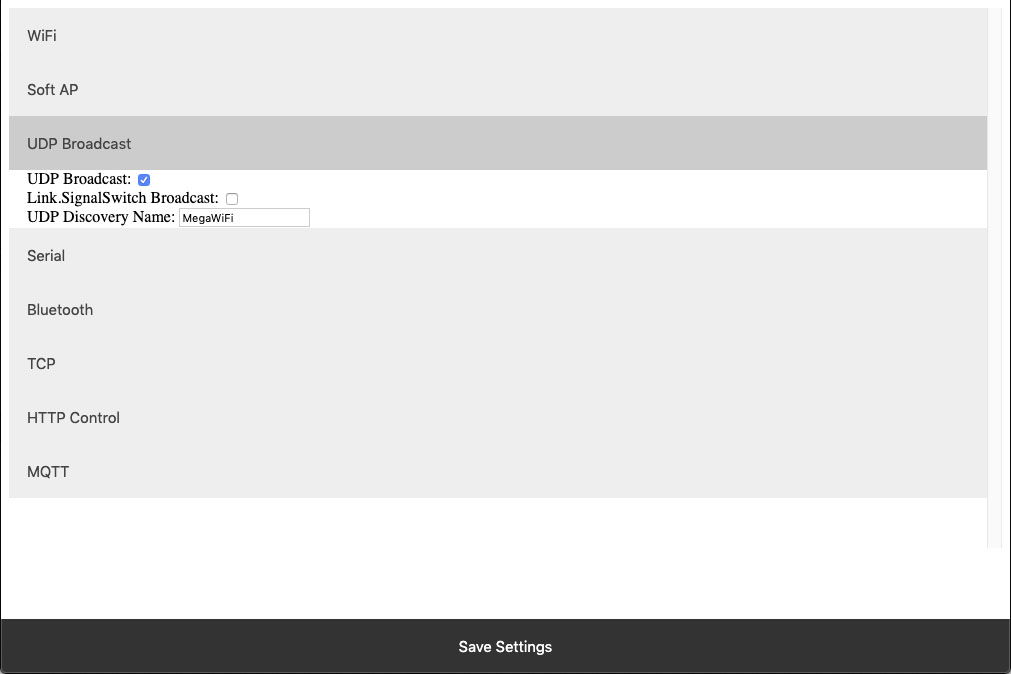 The NexGen module broadcasts a UDP packet on ports 55555 and 13000 for network discovery purposes.  These settings enable this broadcast, forward the broadcast to link.signalswitch.com and alter the name in the discovery packet.
The NexGen module broadcasts a UDP packet on ports 55555 and 13000 for network discovery purposes.  These settings enable this broadcast, forward the broadcast to link.signalswitch.com and alter the name in the discovery packet.
UDP Broadcast
This setting indicates whether or not the WiFi module should send out a network discovery UDP packet on interval.Link.SignalSwitch Broadcast
This setting indicates whether or not the WiFi module should send a discovery packet to link.signalswitch.com on interval or not.UDP Discovery Name
This setting configures the Name field to be send in UDP broadcast packets. This can be used to differentiate multiple devices on the same network.Serial
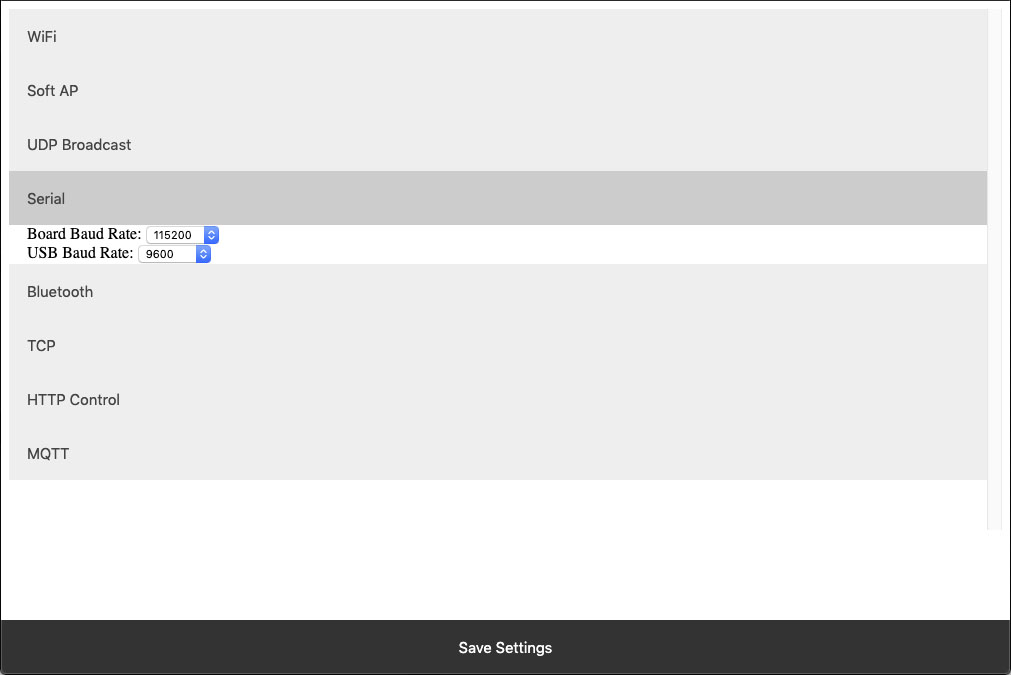 The WiFi module technically has two serial interfaces.  One which communicates through the USB port on the module and a second that communicates to the host board.  These settings apply to those ports.  Keep in mind most Host boards manufactured by NCD have a default baud rate of 115200.
The WiFi module technically has two serial interfaces.  One which communicates through the USB port on the module and a second that communicates to the host board.  These settings apply to those ports.  Keep in mind most Host boards manufactured by NCD have a default baud rate of 115200.
Board Baud Rate
Baud rate of the NexGen module’s serial interface connected to the Host board. Most NCD boards have a default baud rate of 115200. This setting must match the baud rate of the host board.USB Baud Rate
The baud rate for WiFi module’s USB connection. Software connected to the board via USB must match this baud rate.Bluetooth
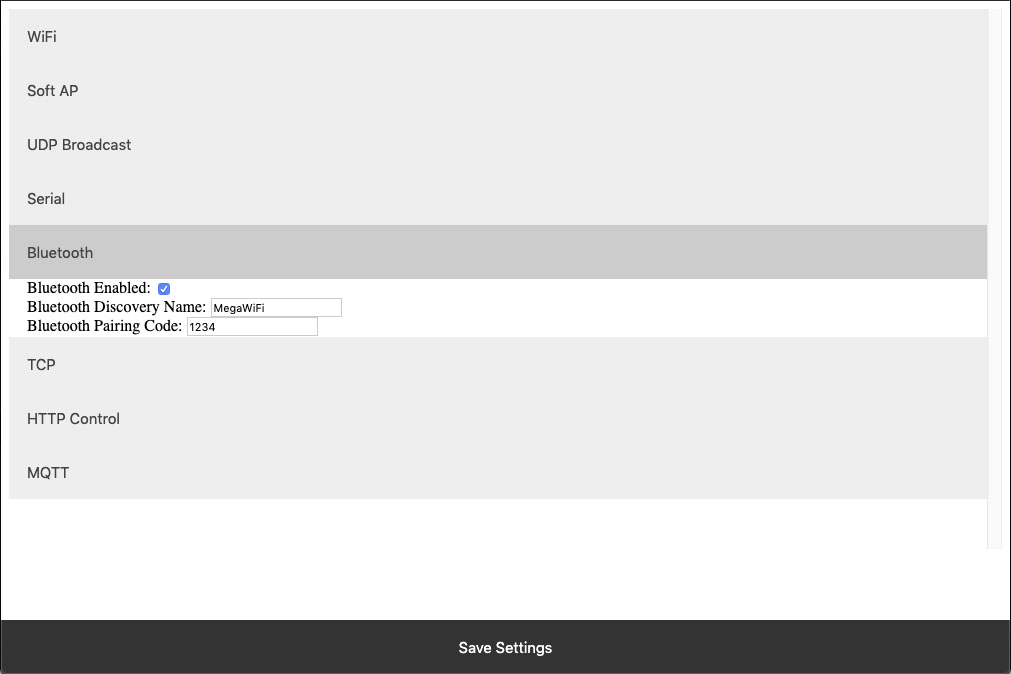 The NexGen module supports Bluetooth connectivity via the Bluetooth Classic protocol. It implements the functionality of a Bluetooth Serial Port Profile device(SPP). It does not implement Bluetooth 4.0 or LE functionality and thus is not compatible with all devices such as iOS.
The NexGen module supports Bluetooth connectivity via the Bluetooth Classic protocol. It implements the functionality of a Bluetooth Serial Port Profile device(SPP). It does not implement Bluetooth 4.0 or LE functionality and thus is not compatible with all devices such as iOS. Bluetooth Enabled
This setting indicates whether or not the NexGen Module should implement bluetooth connectivity.Bluetooth Discovery Name
This is the name which will appear in Bluetooth device scans.Bluetooth Pairing Code
Pairing code required for Bluetooth pairing with the device.TCP
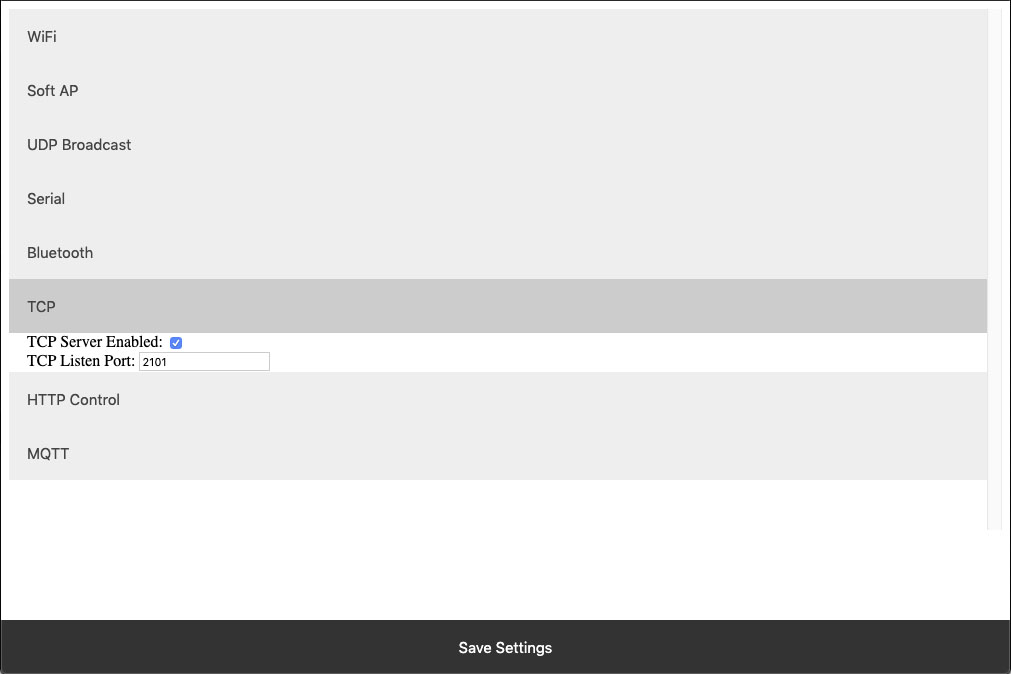 The NexGen module implements the functionality of a TCP server. In this implementation the module opens a socket which clients(software) can connect too. These settings configure this TCP Server functionality.
The NexGen module implements the functionality of a TCP server. In this implementation the module opens a socket which clients(software) can connect too. These settings configure this TCP Server functionality.
TCP Server Enabled
Whether or not to allow TCP clients to connect.TCP Listen Port
The port on which to listen and allow for TCP Client connections.HTTP Control
The NexGen module supports a rudimentary web interface for manually turning relays on and off. This interface only supports ProXR, ProXR Lite, Fusion, and Taralist relay controllers with 8 or fewer relays. This interface is available at {device IP address}/Control.HTTP Control Enabled
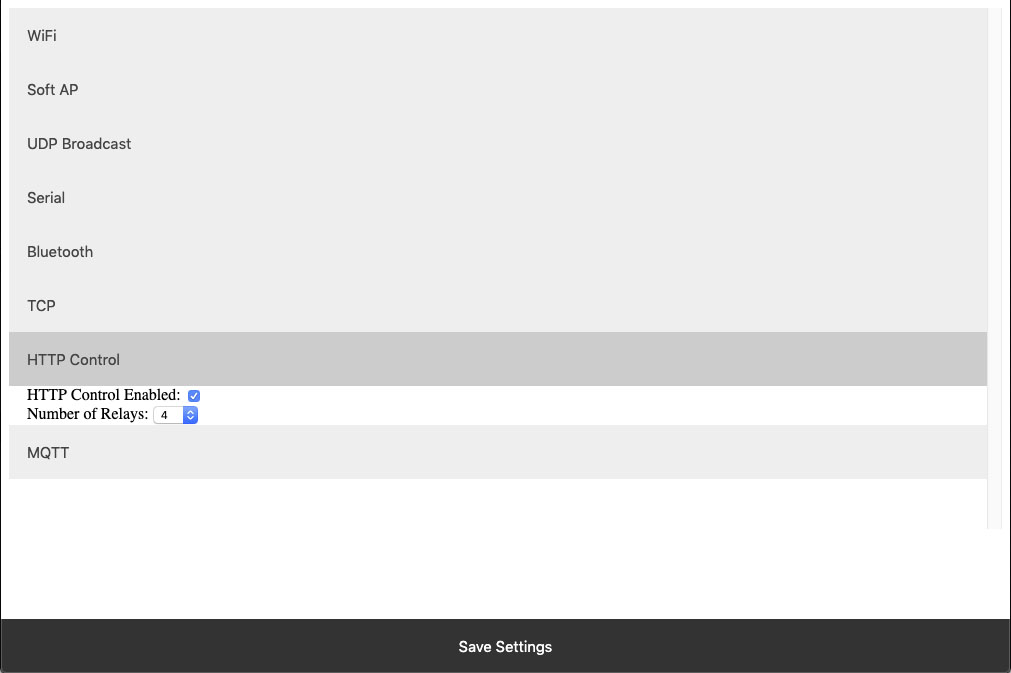 Whether or not to display the HTTP control interface. Select this option if you want to activated the built-in web page to control the relay. Below select how many relays you have on the board, compatible on boards with up to 8 relays installed.
Whether or not to display the HTTP control interface. Select this option if you want to activated the built-in web page to control the relay. Below select how many relays you have on the board, compatible on boards with up to 8 relays installed. Number of Relays
This setting determines the number of relay control sets to display on the control interface. Match this to the number of relays on the board. This ferature is only compatible with boards with 8 relays or less.MQTT
The NexGen module supports very basic MQTT usage. It can be configured to connect to an MQTT broker using no auth or basic auth(username/password). Testing of this functionality was done using beebotte.comThe module only implements one subscribe topic and one publish topic. It listens for control commands over the subscribe topic and sends command responses to the publish topic. Commands should be published to the subscribe topic in a JSON packet. The JSON packet must contain one key value pair with a key of sendCommand and the value for that pair must be a JSON array of command bytes. Example: {“sendCommand”:[254,108,1]}. The WiFi module will publish data received from the host board to the Publish topic. This Publish payload will contain a JSON packet. The format of the packet is a single key value pair with the key of data and the value will be an array of bytes. Example: {“data”:[170,1,85,1]}
MQTT Enabled
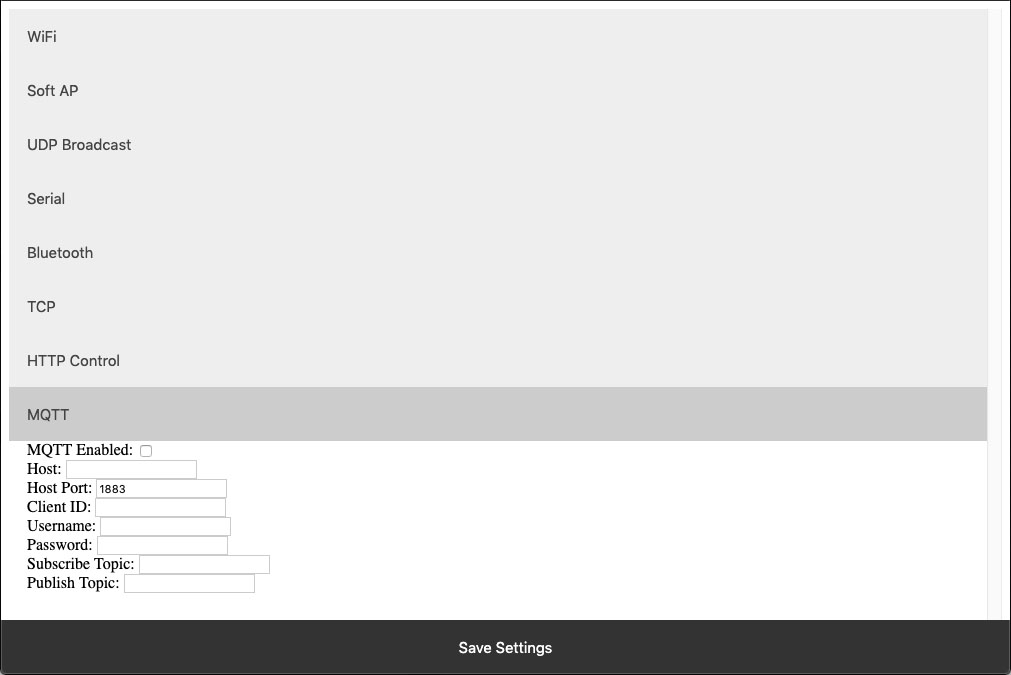 Whether or not to implement MQTT functionality and establish connection to an MQTT broker on boot.
Whether or not to implement MQTT functionality and establish connection to an MQTT broker on boot.
HOST
The Host URL for The MQTT broker.Host Port
The port on which to connect to The MQTT broker.Client ID
The Client ID to use for The MQTT connection.Username
The user name to use for basic authentication with The MQTT broker.Password
The password to use for basic authentication with The MQTT broker.Subscribe Topic
The Topic to subscribe to for host board control commandsPublish Topic
The Topic which to publish data to when data is received from the Host board.HTTP API
The NexGen module supports HTTP GET requests for sending commands to the host board. There are a few different end points for the HTTP Get requests:/relayCount
- A Get request to this end point will return the number of relays on the board(this is configured under Number of relays setting under HTTP Control. - Example: 192.168.1.10/relayCount/relayON
- A GET request to this end point will turn the specified relay on. This GET request requires one arg with the key relay and the value of the relay which to control(valid range for relay number is 1-256) - The board should respond to this GET request with an 85. - Example: 192.168.1.10/relayON?relay=1/relayOFF
- A GET request to this end point will turn the specified relay off. This GET request requires one arg with the key relay and the value of the relay which to control(valid range for relay number is 1-256) - The board should respond to this GET request with an 85. - Example: 192.168.1.10/relayOFF?relay=1/sendCommand
- A GET request to this end point allows the user to send any command to the board they wish. This GET request requires one arg with the key of data and a value of an array of bytes which to send to the host board. - Once the host board has processed the command this GET request will respond with the data returned from the host board. - Example: 192.168.1.10/sendCommand?data:[254,108,1]Web Socket
The NexGen module supports web sockets. Users can establish a web socket to the board via ws://{controller IP}/wsThis web socket expects command bytes to be sent in the form of a JSON array, for example “[254,108,1]”. Note this array should be sent in TEXT/String format as shown with quotes.
Any data received from the host board will be sent to the web socket in the same format (JSON Array).
RGB status LED
The NexGen module has an RGB status LED which is used to indicate the current state of the module to the user visually. Possible statuses are:Flashing Green
The module is running normally but no connections to it have been established.Solid Green
The module is running normally and a connection has been established with the board via software. This will happen when a TCP socket is connected to the board.Flashing Blue
Module is in configuration mode and should appear as a network in WiFi Scans.Flashing Yellow<
Module is booting.Orange Flash
The LED will flash Orange any time data is received over any connection (USB, TCP, Bluetooth, MQTT, etc).Flashing Red
Indicates the module is unable to connect to the WiFi network.Taralist
Taralist NTP Sync Enabled
This option enables Network Time Protocol time syncing of the Taralist Real Time clock. When enabled, once per day the NexGen module will sync it’s time with time.google.com, then it will update the on board Taralist Real Time clock. Note that this feature is only valid on Taralist series relay controllers and will only work if WiFi is enabled and internet connectivity is present on the connected WiFi Network.
UTC Timezone Offset
This setting determines the timezone for NTP clock syncing. Set it to your particular timezone’s UTC offset not factoring in DST. For instance Central Standard Time’s UTC offset is -6, Eastern Standard Time is -5, etc.
Enable Daylight Savings Time
When enabled the controller will offset it’s clock during Daylight savings time.
Viewing the NexGen Module’s NTP time and the on board Taralist Real Time Clock Time.
After Taralist settings have been entered and WiFi settings have been entered and saved to the NexGen module it should connect to your WiFi network and the RGB LED should be flashing green indicating everything is functional. On a computer on the same network as the controller open a web browser and enter the controller’s IP address followed by /Taralist for example: 192.168.0.2/Taralist. The returned HTML page will display both the NTP clock time and the on board Taralist real time clock time. This time is updated nearly once per second. If everything looks valid go ahead and close the page, Taralist is now fully functional. Note do not leave this page open as it taxes the processor to update the web page once per second.
Taralist NTP Sync Enabled
This option enables Network Time Protocol time syncing of the Taralist Real Time clock. When enabled, once per day the NexGen module will sync it’s time with time.google.com, then it will update the on board Taralist Real Time clock. Note that this feature is only valid on Taralist series relay controllers and will only work if WiFi is enabled and internet connectivity is present on the connected WiFi Network.UTC Timezone Offset
This setting determines the timezone for NTP clock syncing. Set it to your particular timezone’s UTC offset not factoring in DST. For instance Central Standard Time’s UTC offset is -6, Eastern Standard Time is -5, etc.Enable Daylight Savings Time
When enabled the controller will offset it’s clock during Daylight savings time.Viewing the NexGen Module’s NTP time and the on board Taralist Real Time Clock Time.
After Taralist settings have been entered and WiFi settings have been entered and saved to the NexGen module it should connect to your WiFi network and the RGB LED should be flashing green indicating everything is functional. On a computer on the same network as the controller open a web browser and enter the controller’s IP address followed by /Taralist for example: 192.168.0.2/Taralist. The returned HTML page will display both the NTP clock time and the on board Taralist real time clock time. This time is updated nearly once per second. If everything looks valid go ahead and close the page, Taralist is now fully functional. Note do not leave this page open as it taxes the processor to update the web page once per second.ProXR Expandable Board
This Board includes the XR Expansion Port for adding additional relays to the board. The XR Expansion Boards can be added to control up to 256 relays on this board!
The ProXR Relay Board
ProXR Relay
We've looked at the interface now let's take a look at the board design and programming. The ProXR series controllers are manufactured by hand for a highly accurate and reliable design. Equipped with the XR Expansion Port additional relays can be easily added. Fully tested before they leave the production facility each ProXR controller is ready to stand up to rigorous demands from heat, cold or vibration. The best test of all is the numerous boards in the field from customers all over the world in all sorts of conditions. Take it from us, these controllers will hold up!UXP Expansion
UXP is a standardized data port, specifically for the purpose of speaking to various expansion modules. This controller is equipped with a UXP port, you can take advantage of extended commands to speak to our growing line of I/O expansion modules. You will find the UXP port on models with UXP in the part number.UXP Expansion Modules
UXP Expansion Boards have no on-board brains. They are entirely reliant on the brains of a "master" device. A master device is an NCD controller with a UXP expansion port and a microprocessor of some kind. Most master UXP devices have on-board relays. If you need to add A/D, Contact Closure Inputs or Digital Potentiometers just plug in the appropriate expansion module. You cannot daisy chain different types of modules to the same controller however. In other words if you plug in a potentiometer you will not be able to plug a contact closure or A/D module also. For controllers that are equipped with a UXP Expansion port (and are suitable master devices for UXP Series Expansion) simply look for UXP in the part number. All UXP Expansion Modules have an input and an output so you can simply daisy chain the boards together until you reach the number of contacts you are looking for.- Summary of UXP Modules
- Compatible with UXP Series Controllers ONLY
- Not a stand-alone controller - MUST be used with a UXP Series Controller
- Add Contact Closure Inputs
- up to 256 Inputs - Add Analog to Digital Inputs
- up to 48 Inputs - Add Digital Potentiometer Outputs
- up to 256 Outputs
XR Expansion Port
Most UXP controllers (Master Devices) have an XR expansion port and therefore can accommodate XR Expansion Boards. Typically the XR Expansion port is used to add relays to the main controller (Master Device). Like the UXP Expansion boards the XR Expansion Boards have no on-board brains. They are entirely reliant on the brains of a "master" device. When you run out of relays, just plug in an XR expansion board that is equipped with the kind of relays you need. You can add up to 256 relays including the relays that are on the main controller (Master Device). All XR Expansion modules are compatible with each other so if you want to add different types of relays you can. For controllers that are equipped with an XR Expansion port (and are suitable master devices for XR Series Expansion Controllers) simply look for PROXR in the part number.Using XR and UXP Together
If you select a board that is equipped with both XR and UXP port you can use both ports simultaneously. This allows you to add and control more relays through the XR port plus add A/D, Contact Closures or Potentiometers to the same board through the UXP port. This can all be controlled through the same virtual COM port on your computer. These Expansion Boards can be purchase with the controller or purchased at a later time when you have a need to expand. To use both ports together you will need to select a controller that has UXP and PROXR in the part number to have bothports available on the controller (Master Device).ProXR Enhanced Firmware Installed
This board has ProXR Firmware installed that responds to the full ProXR Command Set. The ProXR Firmware is the industry leading firmware for controlling relays with more commands and functionality than any other board on the market. The list of commands and parameters this board is capable of is extensive. ProXR Enhanced is the newly released enhance version of the ProXR Firmware with more commands, more functionality and better control than ever before! For a detailed list of all the commands with descriptions see our ProXR Enhanced Command Set.Base Station Software
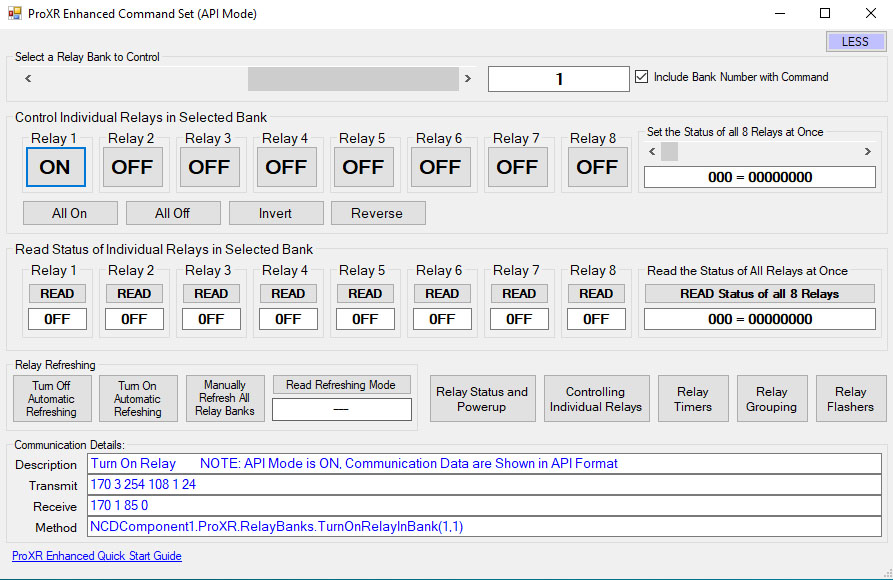 Base Station Software was designed to help you learn the ProXR command set. Explore ProXR features using it's Graphical User Interface. Watch data bytes flow to and from the board, so you easily understand the command execution process. There is no faster or easier way to learn how to automate than Base Station, as it was designed to work with the complete array of communication modules. Base Station software supports every feature of this device - no other controller manufacturer even comes close to offering this type of software.
Base Station Software was designed to help you learn the ProXR command set. Explore ProXR features using it's Graphical User Interface. Watch data bytes flow to and from the board, so you easily understand the command execution process. There is no faster or easier way to learn how to automate than Base Station, as it was designed to work with the complete array of communication modules. Base Station software supports every feature of this device - no other controller manufacturer even comes close to offering this type of software. SPST Relay Installed
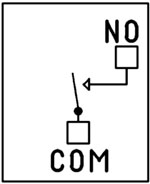 This device has SPST relays installed. SPST Single Pole Single Throw Relays simply connect two wires together.
This device has SPST relays installed. SPST Single Pole Single Throw Relays simply connect two wires together. 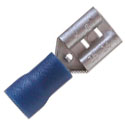 The Common (COM) is the
moving part of the relay that comes in contact with the Normally Open (NO) when the coil to the relay is energized. Wiring is done directly to the Relay terminals using a common 1/4" quick disconnect terminal. To the left is a picture of the connector that will connect to the relay.
The Common (COM) is the
moving part of the relay that comes in contact with the Normally Open (NO) when the coil to the relay is energized. Wiring is done directly to the Relay terminals using a common 1/4" quick disconnect terminal. To the left is a picture of the connector that will connect to the relay.
2-Million Cycles
ProXR series controllers are designed for long life, you should expect to get years of service from your controller and literally 2-million cycles from the relays on board. With a 5-year warranty and a money back guarantee you have nothing to loose! Place your order now, while everything is in front of you.Essential Power Requirements
Applying Good clean power to the board is essential for the operation of the board. Not only for the switching of the relays but the firmware that processes the commands. Without good steady clean power from a regulated power supply the board simply will not function correctly. All boards on the site require 12 VDC power. The PWR12 US power supply is a 120VAC to 12VDC 1.25A 60Hz regulated power supply and it plugs into the barrel connector on the board. The output connector is a 2.1mm I.D. x 5.5mm O.D. x 9.5mm Female R/A barrel connector. We also carry an international power supply with interchangeable adapters for international customers. Learn MoreThis Board is RoHS Compliant
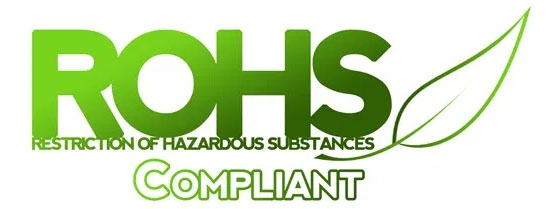 This board is led free and RoHS Compliant. If your requirements are for RoHS compliant parts this board is manufactured with RoHS compliant led free parts and solder.
This board is led free and RoHS Compliant. If your requirements are for RoHS compliant parts this board is manufactured with RoHS compliant led free parts and solder.
16 User-Programmable Timers
The ProXR Series controllers have 16 user-programmable timers. Each independent timer can be assigned to any relay, and can be programmed to hold the relay in the On state, or to pulse the relay at the end of the timer. The ProXR timing features are ideally suited for Watchdog, Keep Alive, and Server Reboot applications, as well as sprinkler systems, gate openers, and lighting applications. Relay Timing Features support two modes of operation: Duration and Pulse. Duration timing is ideally suited where a device should be activated for a period of time. Pulse timing mode is designed specifically for server reboot applications, whereby, if the timer is not reset periodically by your software, the timer will run out and reboot your computer.Easy Software Development
Most of our customers write their own program for controlling these devices. Since you can use almost any programming language, you can use one that is most familiar to you so you don't have to learn a new language. These boards support the Serial Port Profile, meaning they will mount to the computer as a virtual com port. This makes it very easy to send commands to the device.Plug-In for Visual Studio
The NCD Component Library is a plug-in for the Visual Studio 2005/2008 that greatly simplifies the communications to the NCD product line. The samples can be run in Visual Studio and full customization to your needs. Over 40 samples included with this free download! Component Library.5-Year Warranty/Money Back Guarantee
ProXR Lite series controllers are guaranteed against manufacturing and functionality defects for a full 5 years! Not to mention a 30-day money back guarantee! If for any reason you are not happy with a relay purchased from Relay Pros, simply return it within 30 days and we will give you your money back! Controllers that are damaged by our customers will not of course be warranted under any circumstances.Induction Suppression
 Perhaps the most overlooked aspect of relay control is proper handling of inductive loads. Inductive loads can best be defined as anything with a magnetic coil, such as a motor, solenoid, or a transformer. Controlling a inductive load using this relay board requires an induction suppression capacitor for each relay being used. The purpose of this capacitor is to absorb the high voltages generated by inductive loads, blocking them from the contacts of the relay. Without this capacitor, the lifespan of the relay will be greatly reduced. Induction can be so severe that it interferes with the logic of the board, causing relay banks to shut down unexpectedly. For more information view our Induction Suppression Video.
Perhaps the most overlooked aspect of relay control is proper handling of inductive loads. Inductive loads can best be defined as anything with a magnetic coil, such as a motor, solenoid, or a transformer. Controlling a inductive load using this relay board requires an induction suppression capacitor for each relay being used. The purpose of this capacitor is to absorb the high voltages generated by inductive loads, blocking them from the contacts of the relay. Without this capacitor, the lifespan of the relay will be greatly reduced. Induction can be so severe that it interferes with the logic of the board, causing relay banks to shut down unexpectedly. For more information view our Induction Suppression Video.
Shipping
The boards sold are brand new units shipped from our office conveniently located in Missouri. These boards are completely tested before they are released for shipping With so many boards on our site it is impossible to stock boards, please allow two to three days production time for your order to ship. If you have any questions please feel free to call our office at 800-960-4287 or e-mail us at sales@relaypros.com.ProXR Control Is Here!
A more streamlined manufacturing process brings a more durable, reliable and better relay board to the market. Here's a lists of great features:- User Friendly Board Design
- "Wall Wart" or direct power capability
- Relay status light bar
- XR Expansion Port - easily add more relays
- Easy screw terminal connections
- DPDT Relays with 2 connections per relay
- ProXR Features
- Works with the full ProXR Enhanced Command Set
- 8-Channel 8/10-Bit Analog to Digital Converter
- Highly reliable relay with industry leading command set
- 16 programmable timers available
ProXR Videos
ProXR Command Set
The ProXR Command Set is the industry leading command set for controling relays! You can find the complete command set in the ProXR Quick Start Guide.
The ProXR Command Set
ProXR Firmware
The firmware on the Ethernet Relay board supports the ProXR Command Set, offering more commands and functionality than any other relay board on the market! The list of available commands and parameters is extensive, giving you full control. You can write your own control program in almost any programming language.Key Features
- Extensive Command Set: More commands and functionality than any other relay board.
- Programming Flexibility: Compatible with nearly any programming language.
- User-Friendly Software: Free software available for non-programmers to easily control relays without coding.
Introduction
The ProXR Series Controllers allow you to control up to 2048 relays depending on your controller model. Relays are divided into groups of 8 called banks, and are addressed by their bank number. For instance, a ProXR series controller with 32 on-board relays has four on-board banks, the on-board relays respond to bank values of 1-4. If you use the XR Expansion port to add another bank of 24 relays, then you will need to specify bank values of 5-7 to control the extra relays. The firmware doesn’t actually know how many relays are attached to the relay controller, it is up to the user to define how many relays are attached to the controller using Base Station Software. The ProXR CPU will assume you have connected the maximum number of supported relays to your controller. In the ProXR Quick Start Guide, you will see two commands that appear to do the same thing, for example:254 0-7 Turn Off Individual Relays
254 100-107 Bank# Turn Off Individual Relays in Bank
254 8-15 Turn On Individual Relays
254 108-115 Turn On Individual Relays in Bank
254 16-23 Get the Status of an Individual Relay
254 116-123 Bank# Get the Status of an Individual Relay in Bank
While the outcome is the same, these commands function in slightly different ways.
For instance:
254 8 Turn On Relay 1
To make this command work, you will send a 254, then a 8 to activate a relay. By default, relay bank 1 will be affected by this command. However, you can redirect this command to a different relay bank using the following command:
254 49 2 Direct Commands to Relay Bank 2
Then you can send:
254 8 Turn On Relay 1 in Bank 2
Here are a few more Bank Specified Examples:
254 49 1 Direct Commands to Relay Bank 1
254 8 Turn On Relay 1 in Bank 1
254 49 2 Direct Commands to Relay Bank 2
254 8 Turn On Relay 1 in Bank 2
254 9 Turn On Relay 2 in Bank 2
254 10 Turn On Relay 3 in Bank 2
254 49 3 Direct Commands to Relay Bank 3
254 8 Turn On Relay 1 in Bank 3
254 11 Turn On Relay 4 in Bank 3
254 12 Turn On Relay 5 in Bank 3
254 13 Turn On Relay 6 in Bank 3
254 14 Turn On Relay 7 in Bank 3
254 49 0 Direct Commands to All Relay Banks
254 8 Turn On Relay 1 in All Relay Banks
This command structure has the advantage of being very fast and efficient. However, if power to the controller is ever lost, commands will automatically be directed to bank 1 when power to the controller has been restored. This command methodology is generally advisable for ProXR controllers with 8 or fewer relays. When working with more than 8 relays, we generally advise users to use Bank Directed commands as shown in the following examples.
Turns Off Relays in the Currently Selected Relay Bank
This command will control the Off status of specified relays in the Currently Selected Relay Bank. This command has optional parameters <1-7> for controlling the Off status of the remaining relays, 1 being the next relay in sequence, 2-7 being all possible subsequent relays in the selected relay bank. A value of 0 refers to the first relay in the specified relay bank, 7 being the 8th and final relay of the selected Relay Bank. This command sends byte value 85 back to the user when the operation has been completed.| Send Bytes: | Byte 1: | Byte 2: | Byte 3: |
| Function: | Command | Command | Optional Parameters |
| Decimal Values: | 254 | 0-7 | 1-7 |
| Hex Values | 0xFE | 0x00 - 0x07 | 0x01 - 0x07 |
| Receive Byte: | Decimal: | 85 | |
| Hex: | 0x55 |
Turns On Relays in the Currently Selected Relay Bank
This command will control the On status of specified relays in the Currently Selected Relay Bank. This command has optional parameters <1-7> for controlling the On status of the remaining relays, 1 being the next relay in sequence, 2-7 being all possible subsequent relays in the selected relay bank. A value of 0 refers to the first relay in the specified relay bank, 7 being the 8th and final relay of the selected Relay Bank. This command sends byte value 85 back to the user when the operation has been completed.| Send Bytes: | Byte 1: | Byte 2: | Byte 3: |
| Function: | Command | Command | Optional Parameters |
| Decimal Values: | 254 | 8-15 | 1-7 |
| Hex Values | 0xFE | 0x08 - 0x0F | 0x01 - 0x07 |
| Receive Byte: | Decimal: | 85 | |
| Hex: | 0x55 |
Read the Status of Relays in the Currently Selected Relay Bank
This command will report the On/Off status of Relays 0-7 in the Currently Selected Relay Bank. This command sends byte value of 0 of 1 back to the user when the operation has been completed, 0 reporting an Off status and 1 reporting an On status.| Send Bytes: | Byte 1: | Byte 2: |
| Function: | Command | Command |
| Decimal Values: | 254 | 16-23 |
| Hex Values | 0xFE | 0x10 - 0x17 |
| Receive Byte: | Decimal: | 0 or 1 |
| Hex: | 0x00 or 0x01 |
Full Command Set
These are only a few examples from the ProXR Command set so you can get an idea of the command structure. Download the ProXR Quick Start Guide to view the full command set ProXR Quick Start Guide.Base Station Software
 Base Station Software was designed to help you learn the ProXR command set! No other relay board manufacturer even comes close to offering this type of software! Explore ProXR features using it's Graphical User Interface. Watch data bytes flow to and from the board, so you easily understand the command execution process. There is no faster or easier way to learn how to automate than Base Station, as it was designed to work with all the communication modules we offer! You only need a Windows 8 or 10 Computer to Run Base Station.
Base Station Software was designed to help you learn the ProXR command set! No other relay board manufacturer even comes close to offering this type of software! Explore ProXR features using it's Graphical User Interface. Watch data bytes flow to and from the board, so you easily understand the command execution process. There is no faster or easier way to learn how to automate than Base Station, as it was designed to work with all the communication modules we offer! You only need a Windows 8 or 10 Computer to Run Base Station. Base Station Features
There are some useful features to look for when using Base Station Software to control, test, or configure your device:- At the bottom left corner of each window there is a link to relevant documentation for your device
- In the Control Command Set Window, and many others, there is a MORE or LESS option at the top right corner. Selecting MORE allows you to view specific communication details.
- All the functions of the command set are available as a point-and-click interface plus you can see the command that is being sent to the board!
Building a Power Budget
This controller is designed to operate reliably between 9 - 14VDC. Voltages outside this range may lead to unstable performance. Use the tables below to create a power budget tailored to your setup - factor in your communication module and the expected relay activation time to ensure your system stays within safe operating limits.
Power & More
20/30 Amp Relay Board Specifications
This table highlights performance ratings for all NCD controllers equipped with 20A or 30A relays, based on 12VDC operation at 70°F (21°C). Most values are estimated and may be refined over time. Some ratings reflect standard factory settings before any performance optimizations are applied.| Specs of NCD SPDT Relay Boards | Minimum | Nominal | Maximum | Notes |
| Operational Voltages | 10VDC | 12VDC | 15VDC | |
| Standby Power Consumption | 35mA | 100mA | 200mA | No Active Relays, No Com Module |
| Relay Power Consumption | 28mA | 35mA | 60mA | Consumption of Each Activated Relay |
| Operational Temperature Range | -40°F (-40°C) | 70°F (21°C) | 185°F (85°C) | Theoretical Component Limits Shown |
| Storage Temperature Range | -67°F (-55°C) | 70°F (21°C) | 185°F (85°C) |
Theoretical Component Limits Shown |
| Operational Ambient Air Humidity | 0% | 50% | 70% | Non-Condensing Humidity Values Shown |
| Relay Activation Time | 15ms | Needs Further Validation | ||
| Relay Deactivation Time | 10mS | Needs Further Validation | ||
| Operational Life Mechanical | 10,000,000 | Component Operation Rating | ||
| Operational Life Electrical | 100,000 | Component Rating at Maximum Load |
Communication Modules
Communication Module Specifications
This table provides a quick, clear overview of all NCD Communication Modules. While each module operates at 3.3VDC, the values shown here reflect the impact on a 12VDC master controller at 70°F (21°C). Use the maximum ratings for power-budget planning - they represent short-term peak consumption and may include estimated values that are updated as modules evolve.| Specs of NCD Communication Modules | Minimum | Nominal | Maximum | Notes |
| Operational Temperature Range | -40°F (-40°C) | 70°F (21°C) | 185°F (85°C) | Theoretical Component Limits Shown |
| Storage Temperature Range | -67°F (-55°C) | 70°F (21°C) | 185°F (85°C) | Theoretical Component Limits Shown |
| Operational Ambient Air Humidity | 0% | 50% | 70% | Non-Condensing Humidity Values Shown |
| USB Module Power Consumption | N/A | N/A | N/A |
USB Modules are Powered by the USB Port Do Not Consume Device Current |
| RS-232 Module Power Consumption | 10mA | 20mA |
|
|
| Ethernet Module Power Consumption | 58mA | 82mA | 100mA | |
| WiFi Bluetooth USB Module Power Consumption | 37mA | 50mA | 100mA | Up to 300 Foot Indoor Wireless Range, Unobstructed. Up to 50 Foot Range Through Walls |
| 900MHz Wireless Module Power Consumption | 13mA | 30mA | 50mA | Up to 1,000 Foot Indoor Wireless Range, up to 2 Mile Outdoor Wireless Range using Included Antennas. Up to 28 Miles Outdoor Wireless Range using High-Gain Antennas. |
| KFX Wireless Key Fob | 11mA | 15mA | 25mA | Up to 200 Feet Outdoor Wireless Range using 1, 2, 3, 4, or 5 Button Key Fobs. Up to 700 Feet Outdoor Wireless Range using 8-Button Remotes |
A/D Inputs
AD8 Analog Input Usage Notice
Analog inputs should never have voltage applied when the controller is powered down. If your application requires voltage to remain on an input, add a 220-ohm current-limiting resistor to each channel to protect the controller from damage.Keep all analog inputs within the 0 - 5VDC range - exceeding this limit can permanently damage the on-board CPU. Most inputs include a 10K pull-up or pull-down resistor to keep the line stable when unused, but note that this resistor may introduce a slight bias in readings for certain sensors.
Power Supply Available
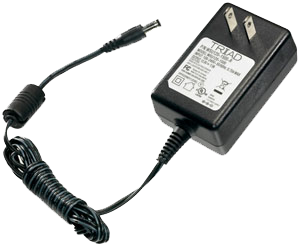 The PWR12 is regulated power supply providing clean power necessary for
the performance of these boards. The PWR12 US power supply is a 120VAC to 12VDC 1.25A 60Hz regulated
power supply and it plugs into the barrel connector on the board. The output connector is a 2.1mm I.D. x 5.5mm
O.D. x 9.5mm R/A barrel connector.
The PWR12 is regulated power supply providing clean power necessary for
the performance of these boards. The PWR12 US power supply is a 120VAC to 12VDC 1.25A 60Hz regulated
power supply and it plugs into the barrel connector on the board. The output connector is a 2.1mm I.D. x 5.5mm
O.D. x 9.5mm R/A barrel connector.
Click Here for More
Induction Suppression
 Controlling
an inductive load using our relay controllers requires the use of induction suppression capacitors. The purpose of this capacitor
is to absorb the high voltages generated by inductive loads, blocking them from the contacts of the relay. Without this capacitor,
the lifespan of the relay will be greatly reduced. Induction can be so severe that it electrically interferes with the microprocessor
logic of our controllers, causing relay banks to shut themselves down unexpectedly.
Click Here for More
Controlling
an inductive load using our relay controllers requires the use of induction suppression capacitors. The purpose of this capacitor
is to absorb the high voltages generated by inductive loads, blocking them from the contacts of the relay. Without this capacitor,
the lifespan of the relay will be greatly reduced. Induction can be so severe that it electrically interferes with the microprocessor
logic of our controllers, causing relay banks to shut themselves down unexpectedly.
Click Here for More
N-Button Lite
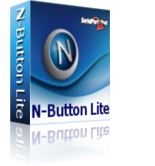 N-Button
Lite is software that allows you to configure buttons to control relays and read the status of those relays without programming. You
can also create meters for reading variable input sensors connected to the board in real time!
N-Button
Lite is software that allows you to configure buttons to control relays and read the status of those relays without programming. You
can also create meters for reading variable input sensors connected to the board in real time!
Available Software
The software on this tab is provided by NCD or trusted third-party developers and is built specifically to work with the boards on this site.
Software Options
Not a programmer and these boards look intimidating? Don't worry. Powerful software tools make it easy to get connected, discover attached devices, monitor inputs in real time, and control relays without writing a single line of code. Create on-screen buttons, desktop meters, timed events, and automated actions that respond to inputs, schedules, or system conditions - all from an intuitive graphical interface.Base Station
Base Station software supports every feature on any ProXR board - no other controller manufacturer even comes close to offering this type of software. Download Base Station.
Base Station Software
Compatible with All Boards on this Site
Base Station is a free software download that works by talking directly to your controller to identify the model, then automatically loads the correct graphical interface for controlling and testing that device. It's a great way to learn how any NCD controller works and doubles as a powerful diagnostic tool to verify your device is operating as designed.Base Station exercises every supported feature on every supported device. For learning, testing, and troubleshooting NCD boards, this is the ultimate reference tool.
User Interface
Base Station gives you a list of command sets supported by your controller. Just click any item once to open the custom graphical interface that was created alongside the firmware. Each command set corresponds with a module installed inside your device."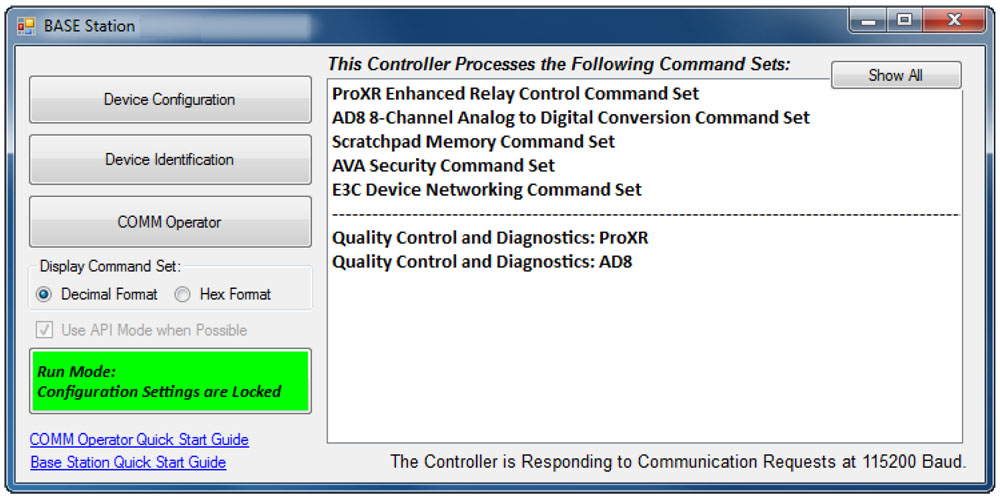
Device Identification
Click the Device Identification window to view important read-only info about your controller.Watch for the field labeled "Documentation Related to this Controller" - it's a complete list of articles connected to your device. Click any entry to open it. (Internet required.)
All devices released in 2012 and later support Device Identification.
Device Command Sets
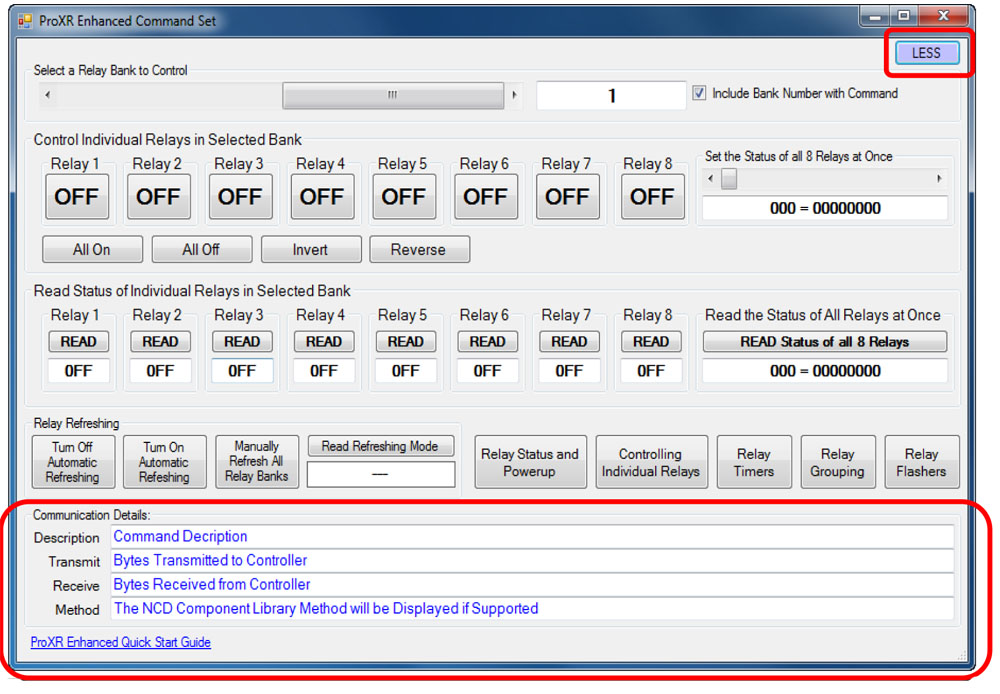 Base Station asks the controller which command sets it supports, then displays them when the software launches. Some devices show more command sets, others fewer - it's always based on the board.
Base Station asks the controller which command sets it supports, then displays them when the software launches. Some devices show more command sets, others fewer - it's always based on the board.
ProXR users can access the entire ProXR Command Set to turn relays on/off and run every available function.
Control All ProXR Functions
Turn relays on or off, read relay status, monitor inputs - Base Station gives full ProXR control through a clean point-and-click interface.For programmers, Base Station also shows every command being sent to the board, making it a great tool for learning and development.
Useful Features
There are some useful features to look for when using Base Station Software to control, test, or configure your device:- Links to Quick Start Guides and documentation/li>
- Discovery of network devices with IP address display
- Command Set Window for viewing raw commands (especially helpful for ProXR users)
- Relay Activator with Analog Inputs
Configure Buttons
N-Button Lite lets you create on-screen buttons to control relays and view their status - no programming needed. You can also build real-time meters to monitor variable input sensors connected to your board.
N-Button Lite - Full Relay Control
Relay Software
N-Button Lite is third-party software (sold separately) that gives you full relay control and real-time A/D input monitoring without writing a single line of code. It may look simple at first glance, but don't let that fool you - this is a surprisingly powerful tool with a wide range of real-world applications.Create desktop buttons and meters, monitor live input values, and control relays instantly - all from an intuitive point-and-click interface.
Create Buttons & Widgets
 N-Button Lite/Pro lets you build floating desktop widgets that can:
N-Button Lite/Pro lets you build floating desktop widgets that can:
- Control relays and read inputss
- Create buttons to control relays
- Read A/D inputs
- Create live meters from inputs
- Launch applications
N-Button also includes special widgets designed specifically for the boards on this site.
Lite vs. Pro
N-Button Lite includes the same buttons and widgets as the Pro version, but is limited to 16 total widgets. It's ideal for maller projects or cost-conscious applications where you still want full functionality. If your project grows, N-Button Pro removes the limit and supports up to 255 widgets.USB and Network Compatible
N-Button Lite works over Serial/USB or Network connections between your computer and the relay board. Add or modify widgets easily using N-Button Lite Manager to create the exact look and behavior you want. N-Button Lite supports this relay board and any ProXR Relay board with up to 16-widgets.Control Multiple Boards
N-Button Lite software can control multiple devices connected to the same computer or network, allowing you to manage relays, inputs, meters, and automation across several boards from a single interface. Use the built-in Device Manager to easily add, remove, or modify boards and maintain a clear list of all connected devices. Each device is handled independently, making it easy to build scalable systems without adding complexity.For example, a single PC can monitor A/D inputs on one board while controlling relays on multiple network-connected boards.
Create Time Schedules
This timer software makes it easy to turn relays on and off automatically at times you choose. Create repeating schedules - daily, weekly, monthly, or on specific days - and connect using USB, serial, or your network.
Time Control Software
Relay Timer
Time Schedule Control
Relay Timer software works with all ProXR and ProXR Lite relay controllers and supports every available interface - USB, wired, wireless, and network. No matter how your board is connected, Relay Timer communicates seamlessly to deliver reliable, scheduled relay control.Precision Scheduling Using Your Computer's Clock
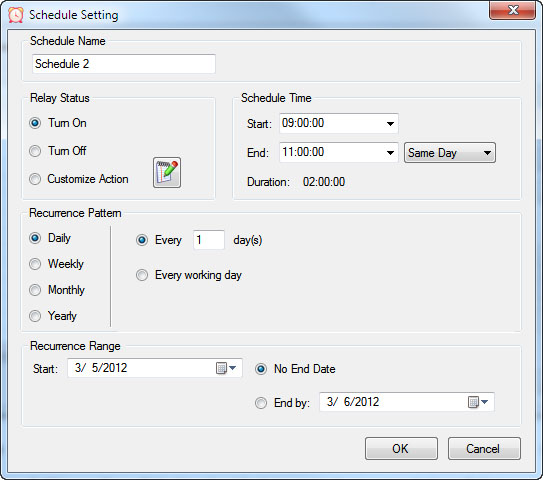 Relay Timer uses the computer's system clock to maintain accurate, drift-free timing. This ensures relay actions stay perfectly synchronized with other applications running on the same machine, such as time clocks or automation software.
Relay Timer uses the computer's system clock to maintain accurate, drift-free timing. This ensures relay actions stay perfectly synchronized with other applications running on the same machine, such as time clocks or automation software.
A high-resolution timing engine - similar to those used in multimedia applications - provides timing accuracy down to 5 - 10 milliseconds, making Relay Timer well suited for real-time and precision-based control tasks.
High-Speed, Multi-Relay Control
Relay Timer can update up to eight relays simultaneously using the ProXR and ProXR Lite communication protocol. When speed matters, all eight relays can be updated in approximately 30 milliseconds.In multi-relay applications, Relay Timer calculates the state of all relays together, even though each relay operates independently. This ensures fast, coordinated, and predictable behavior across complex schedules.
Take Manual Control
At any time, you can manually take control of a relay to interrupt the active schedule. Resume automatic operation instantly or set a specific time for the software to return to scheduled control - ideal for maintenance, testing, or temporary overrides such as school bells for assemblies.Create Time Schedules
QuickTimer lets you turn relays on or off for a set amount of time - just like setting a timer on an oven or microwave. Once the timer starts, the software handles everything automatically.
Quick Timer Software
Compatible with ProXR & ProXR Lite Boards
Quick Timer software works with all ProXR and ProXR Lite relay controllers and supports every available interface, including USB, wired, wireless, and network connections. The software automatically communicates with your board regardless of how it's connected, making setup quick and straightforward. Designed for responsive, duration-based control, Quick Timer delivers fast, reliable relay operation for timed sequences, test cycles, and repeatable automation tasks.Duration-Based Relay Control (Not Time-of-Day Scheduling)
Quick Timer is designed for applications where how long a relay is energized matters more than what time of day it activates. Instead of using the computer's clock, Quick Timer runs sequences based on a defined time duration.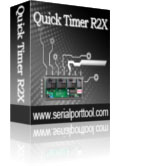
A sequence is manually started and can:
- Run once and stop automatically, or
- Loop continuously until manually stopped
Flexible Time Sequences Within a Single Duration
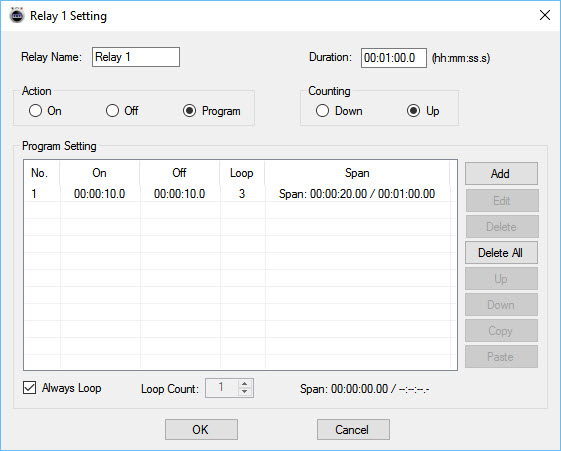 Quick Timer allows you to define a total run duration first. Within that duration, each relay can follow its own independent on/off timing pattern.
Quick Timer allows you to define a total run duration first. Within that duration, each relay can follow its own independent on/off timing pattern.
Example: 30-Second Sequence
- Relay 1 turns on for 5 seconds, then off for 5 seconds
- Relay 2 turns off for 5 seconds, then on for 5 seconds
- Relay 3 turns on for the first 10 seconds, then off for 20 seconds
- Relay 4 remains off for 10 seconds, then turns on for 20 seconds
Independent Control Per Relay
Each relay can be configured with its own timing behavior while remaining synchronized within the overall sequence duration. This allows complex, coordinated relay patterns without requiring scripting or programming.Manual Override at Any Time
Manual control is always available. Interrupt the active sequence to toggle any relay as needed, then return to automatic operation immediately or at a user-defined time.Built for Real-World Reliability
Quick Timer is designed to handle real-world operating conditions, including communication interruptions, power loss, and system instability. Rather than assuming perfect conditions, the software focuses on predictable behavior and clear user control when issues occur.Component Library
Visual Studio Samples
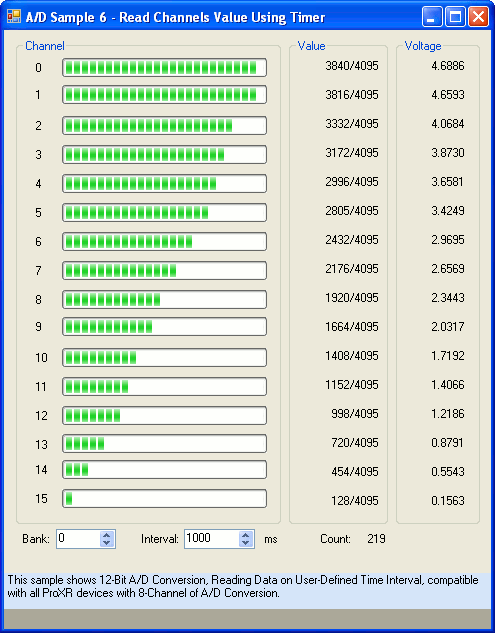 The NCD Component Library is a plug-in for the Visual Studio 2005/2008 that greatly simplifies the communications to the NCD product line. The samples can be run in Visual Studio and fully customizable to your needs. Over 40 fully functional fully working samples are included in this free download.
The NCD Component Library is a plug-in for the Visual Studio 2005/2008 that greatly simplifies the communications to the NCD product line. The samples can be run in Visual Studio and fully customizable to your needs. Over 40 fully functional fully working samples are included in this free download. Visit our Component Library Page to view all the samples available.

